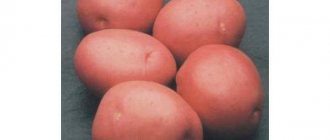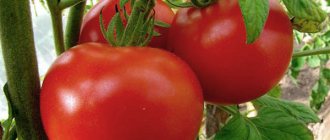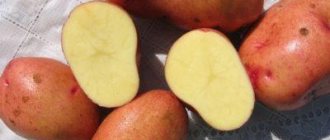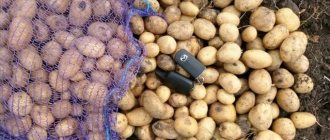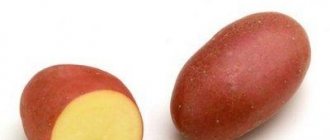Characteristics of the variety
Potato La Perla (La Perla) is an early variety for table use .
The bush is medium-sized, erect, with moderate spreading. Initially, seedlings grow slowly, but later growth accelerates. The leaves are rich green, moderate foliage. Potatoes bloom with medium-sized purple-red flowers with a light tint.
The plant's genes contain high resistance to diseases such as rhizoctonia and leaf curl virus. Under unfavorable factors, seedlings may be affected by late blight.
Distinctive features
Laperla potatoes differ from other varieties in their ultra-early ripening and high yield - up to 400 c/ha. Full maturity occurs 50-65 days after sowing.
With the necessary care and following all the rules, the harvest can be harvested twice. Entrepreneurs noticed this feature, and soon the variety took its rightful place among the most productive crops.
Chemical composition, trace elements and vitamins
It is well known that potatoes can replace bread. But few people know about the nutritional value of the vegetable. First of all, the biological value lies in the high content of vitamin C (up to 25%) and potassium and phosphorus salts. The vitamin composition complements the content of B vitamins, in particular folic acid (B9). In addition to vitamins, potatoes contain organic acids: malic, oxalic and citric.
All microelements contained in tubers are necessary for the full functioning of the human body.
Description of tubers
Average weight - 80-130 g, round-oval shape, yellow peel color . There are a small number of eyes, the occurrence is superficial. The pulp is light yellow (lemon) with a low starch content (up to 14%), does not darken during heat treatment. The taste is high, so potatoes are suitable for preparing any dish.
In the photo on the right are Laperla potatoes.
Tubers have high resistance to mechanical damage . Transportability is excellent; ripe vegetables retain their presentation and taste when transported over any distance.
The shelf life of vegetables is long, the yield of marketable products is up to 95% of the total harvest.
Productivity
Despite the early ripening, with proper cultivation of the soil, the yield reaches 400 c/ha . But this figure is not the limit. It increases on light and fertile soils.
also affect crop productivity . The warmer the area, the richer the harvest will be.
One bush forms 15-20 tubers . All potatoes are even, smooth, beautiful. There are relatively few non-commodity items.
Other potato varieties:
Growing regions
Regions with warm climates are suitable for growing this variety . This is the South of Russia, as well as the Republic of Belarus and Ukraine.
If Laperla potatoes are not picky about the composition of the soil and are able to take root even in heavy soil, then in a cool climate the yield is noticeably reduced .
Landing dates
Typically, potatoes begin to be planted in late April - early May . But this is only possible if return frosts or prolonged rains are not forecast. If the forecast is unfavorable, planting is postponed until the daytime temperature reaches +16...+18ºС, and the soil temperature rises to +10...+12ºС.
Reference. The plant does not tolerate frost well. Cold soil will ruin all seed.
Diseases and parasites
The Laperla potato variety is very resistant to potato blight. There is a possibility of late blight and scab. Infestations of the Colorado potato beetle are also possible.
Late blight
The fungal disease late blight is easier to prevent than to cure, so preventive measures should be taken to protect plants from this disease. Before sowing, tubers are treated with fungicidal preparations. It is recommended to treat the soil where Laperla potatoes will grow with a fungicidal preparation.
The presence of late blight is indicated by the following characteristics:
- formation of brown spots on the leaves;
- the appearance of a white coating on the bottom of the leaf;
- formation of brown spots on tubers;
- subsequent rotting of root crops.
Late blight appears from waterlogging, deficiency of potassium and phosphorus, and excess nitrogen fertilizers. In the early stages of the disease, potatoes can still be saved by treating the bushes and soil with fungicides. In advanced conditions, the infection is incurable and the plants should be removed from the site and burned.
Scab
Scab is also a fungal infection that affects potatoes. Diseased plants can be easily identified by the following characteristics:
- rough, brown growths on tubers;
- potato skin is wrinkled and peeling;
- brown cankers and bumps on plant stems.
Scab appears from contaminated soil in which proper crop rotation is not observed. It predominantly develops on sandy soil types, and rarely appears in slightly acidic soil. Excess wood ash or unrotted manure applied to fertilize the soil contributes to the development of the disease. Scab is also transmitted through planting material.
Before planting, tubers should be treated with Maxim or Fitosporin M. Potato bushes should also be sprayed with these products.
Colorado beetle
A dangerous pest that attacks bushes and tubers is the Colorado potato beetle. To combat this harmful insect you should use:
- on large areas - Prestige or Colorado for spraying plants;
- On small plantations, the Colorado potato beetle is collected by hand and destroyed by soaking in kerosene.
Advantages and disadvantages
The popularity of potatoes among summer residents and entrepreneurs is due to numerous advantages :
- early maturity;
- the ability to harvest twice;
- simple agricultural technology;
- ability to bear fruit in any soil;
- high fruiting rate;
- excellent taste and presentation;
- long shelf life of finished products;
- resistance to long-term transportation;
- universal application;
- resistance to mechanical damage.
Disadvantages include susceptibility to late blight. But with proper care, the likelihood of disease is reduced to a minimum.
Pros and cons of the variety
The Laperla potato variety has many advantages, but the variety has practically no disadvantages.
pros
- Precocity.
- It is possible to dig two crops per season.
- Unpretentiousness to soil type.
- High yield.
- Excellent taste characteristics.
- Versatility of use.
- Good transport characteristics.
- Long shelf life.
- Resistance to potato blight.
Minuses
Among the disadvantages of the variety, characteristics such as poor cold resistance and sensitivity to late blight and scab should be highlighted.
Features of planting and growing
The crop tolerates drought well, but sudden cold snaps have a negative impact on plantings . By planting the plant in light and fertile soil, the yield can be significantly increased.
Pre-sowing preparation
A month before sowing, they begin to prepare the seed - select tubers weighing no more than 100 g. Damaged potatoes are not suitable for planting; select only smooth, light-colored ones without visible damage.
After a thorough inspection, the tubers are laid out in a bright room with a temperature of +15...+17°C for germination. Ungerminated seed material will not sprout.
Low temperatures during germination will result in thin, defective sprouts that will be vulnerable and brittle at planting time. Temperature control is required if you want to get healthy and strong seedlings.
Landing
Before planting La Perla potatoes, it is necessary to prepare the soil and select seed material.
Selection of beds and preparation
La Perla potatoes are undemanding when it comes to soil, but bear fruit better on breathable, light, loose soil. Optimal soils are sandy loam and chernozem. The worst are dense loams. If the soil is loamy, peat and river sand are added to it to loosen it.
Optimal neighbors and predecessors are legumes, onions, garlic, green manure. Also suitable are cucumbers, pumpkin, zucchini, cabbage, radishes, radishes. It should not be planted near tomatoes or in beds after other nightshades for 3-4 seasons.
The soil is dug up to a depth of 30-35 cm in the fall after harvesting. For 1 sq. m add 5-10 kg of humus or compost. In the spring, they dig up again and feed with mineral fertilizers.
Potatoes require neutral acidity. If the soil is acidic (pH more than 5.5-6), add slaked lime, chalk, and dolomite flour.
Tuber preparation
Seed tubers should not be too small (70-90 g each), not spoiled or rotten. Having selected the suitable ones, they are laid out in one layer on a well-lit surface. The optimal temperature is +12-15 degrees.
After 2-4 weeks, the tubers should germinate, and the sprouts should reach a length of 2-3 cm. You can plant with sprouts of 4 cm, but it is better not to wait for longer ones, since the risk of breaking them off during planting increases, and then the bushes will not sprout.
On the eve of planting, the tubers are sprayed with a stimulant solution.
The holes are placed at a distance of 30 cm from each other, row spacing is 70 cm. In loamy and other heavy soils, the depth of the holes should be no more than 5 cm, in light soils - 10-15 cm.
You can put 1-2 handfuls of wood ash at the bottom of the holes to protect the plantings from the Colorado potato beetle.
Advice from gardeners
Advice from experienced gardeners will help beginners in proper care :
- After harvesting the potatoes, plant oats, peas and mustard in these beds. They complement each other perfectly and saturate the soil with useful substances. Oats with mustard are adapted to frost and stand until November. In spring, the beds, filled with useful elements, are ready for planting.
- In the fall, plant winter rye in potato beds. In the spring, it will emerge as a green carpet and improve the health of the earth, preventing the growth of weeds and destroying pathogenic spores.
Buy Potatoes (CARETA variety)
Demand for Potatoes
We purchase potatoes in large volumes, caliber 5+, for schools, kindergartens and other government institutions.
Demand, buy: Potatoes wholesale
I will buy potatoes of the Romano (Ramona) variety in large quantities, preferably in the Stavropol Territory. 4.5+ Long-term cooperation. Vladimir
Demand, buy: Potatoes
Demand, buy: Potatoes wholesale
We regularly buy potato flakes for the production of chips. The need is constant. We will consider all proposals.
I will buy wholesale: Potatoes from 5 tons. To make a decision, you need to send a photo of the potato via WhsApp to . Payment in cash upon delivery to Moscow. With good quality and favorable prices, we are ready for long-term cooperation. Julia
Continue the list (5287)
Reviews
Positive reviews about the culture of many gardeners leave no doubt about the choice of variety.
Ivan, Moscow region : “I learned about La Perla potatoes from photos and descriptions on the Internet. The characteristics interested me, so I decided to plant the variety in my garden. I was pleased with the end result. The fruiting is rich, the vegetables are tasty, and care during the growing season is quite simple. What else does a summer resident need?
Elena, Tver region : “I really like the taste of potatoes. I can use it to cook whatever my heart desires. I boil, fry, stew, add to salads, bake, make pie filling. The taste is always bright and rich, regardless of heat treatment. In a word, potatoes are universal and healthy.”
Photos and descriptions of popular potato varieties + video
Not everyone knows that a huge number of potato varieties are grown in the world. There are exotic species with an unusual taste. We cannot imagine any holiday or ordinary family dinner without a potato dish: mashed, fried, stewed, stuffed, with mushrooms. It is simply impossible to list all the dishes with this root vegetable. Let's move on to studying the most popular types. Let's study potato varieties, photos and descriptions.
Each item has its own flavor and method of preparation, which is hard for the average person to believe. But experienced housewives are well versed in potatoes and know which ones are suitable for mashed potatoes and which ones are suitable for jacket potatoes. So, we present the most popular potato varieties, their photos and descriptions.
When choosing, you should pay attention to storage and resistance to temperature changes and diseases!
Red Scarlett
Dutch breeders did a great job and developed an incredible potato variety - Red Scarlett. Belongs to early ripening, low plant, red-violet flowers. High yield, but often the size of root crops and their quantity depends on climatic conditions. Potato tubers are oblong, smooth, reaching 150 grams. Culinary experts note the culture’s resistance to damage, and after heat treatment the tubers do not change their color. Gardeners love this variety for its easy drought tolerance and resistance to various fungi and diseases.
Potatoes "Sineglazka"
A favorite variety of gardeners and unpretentious in storage, the Sineglazka potato firmly occupies a leading place in popularity among experienced summer residents. Early formation of tubers (during the flowering period) allows gardeners to try new potatoes after 40 days. In cross-section, the tubers are white; the crop received its name due to its blue eyes, which begin to germinate in the spring. The harvest is always consistently rich, from one hundred square meters to 500 kg. The flowers are light blue, large oval-shaped tubers. The variety does not last long, but has excellent taste. Resistant to scab, late blight, bacterial rot.
Description of the variety
Laperla potatoes belong to German selection and are included in the list of early varieties for table use. In the southern regions, farmers easily grow it twice a season, each time getting a magnificent harvest. The variety is suitable for cultivation on different types of soil.
The period of full ripening of Laperla potatoes ranges from 50-65 days (depending on conditions). Usually, young potatoes can be dug up already 40-45 days after planting in the soil.
This variety, like any other, has its own external characteristics. Its bushes are erect, of medium height, moderately spreading. Young plants slowly grow green mass, so the leaves are small, few in number, and have a rich green hue. Laperla does not always bloom due to the short development period. And if flowers do manage to appear, they are usually very small. But it has a pleasant red-violet hue with a barely noticeable light tint.
The root system of this crop is well developed. One bush can produce up to 20 potatoes weighing from 75 to 140 g. With proper care, the yield is high - up to 400 c/ha. This is far from the limit, since under favorable weather conditions such a crop can be grown again in the same season. This feature of the variety was immediately noticed by farmers and entrepreneurs; today it is in great demand by both.
Laperla has a high resistance to some common potato diseases. The vegetable is immune to leaf roll virus, rot, potato cancer, nematode and rhizoctonia. Under unfavorable environmental conditions, plants, especially untreated ones, can be affected by late blight.
Characteristics of the vibrator
An extremely fertile (400 c/ha or more) mature (50-65 days) table variety produced by the breeding and seeding company Solana GmbH&Co.KG (Nimecchina). Viryvnyana bulbs, with a smooth skin of a light yellow color. The pulp is light yellow, the boiling is medium, the savory fruit is good. The bushes are of medium height, the fermentation of the flowers is light, red-violet. It is better to plant it dry and will require standard agricultural technology. Take good care of yourself. The variety is resistant to viruses, rhizoctonia and many other potato diseases. Affected by scab, late blight.
Technology
Warming up in advance, germination and greening (vernalization) 2-4 days. Potatoes are planted between 09-20 weekdays in beds well enriched with organic matter in the early spring. On the day of planting, the bulbs are treated with one of the special complex preparations (Celest-Top, Tirana, Nupred 600). On the ridge, the trees are arranged in two rows in a checkerboard pattern, one to the other. Stand between the bushes in a row of 35 cm. The depth of the throat is 8-10 cm of soil above the potato. Nutrition: 3-4 times with mineral complex supplements with added microelements. Potato fragments are not burnt, the mulch of the beds is solidified, like a warehouse of agricultural machinery. Before flowering, one application of a fungicidal preparation (Infineto, Ridomil Gold, Champion, Kuproxat or others) is carried out together with one of the growth stimulants (Imunocytophyte, Emistim C, Poteytin or others) i) and life-giving components that are present in preparations such as Reacom, Helatin, Novofert and other Zbir - another half of the sickle.
Characteristics of tubers
Tubers of the Laperla variety can be described as follows:
- oval shape;
- sparse superficial ocelli;
- smooth skin, almost without roughness;
- light yellow (lemon) peel color;
- soft yellow flesh;
- starch content – about 14%;
- preservation of pulp color during heat treatment;
- resistance of tubers to mechanical damage, including during transportation;
- high keeping quality – 93-95%;
- excellent taste.
All of the above allows LaPerla potatoes to be included in the list of the best achievements of breeders.
Features of cultivation
Regions with the warmest climates are considered the most suitable for this potato. This is the south of Russia. However, many gardeners successfully grow this variety in other parts of our country.
The culture is not at all demanding on soil. But still, on light and fertile soils, the yield is higher than on heavy and poor soils.
The timing of planting Laperla depends not only on the region, but also on weather conditions. Gardeners know very well what surprises Mother Nature is capable of. Seed material can be planted in the ground at the end of April or early May, but you must be absolutely sure that the danger of frost and prolonged rains has passed. In cooler zones, the start of planting work is delayed until air temperatures reach 16-18 degrees and the ground warms up to 10-12 degrees. If you plant seed tubers in cold soil, many of them can easily die. In this case, don’t expect friendly shoots.
Post-planting care
A couple of weeks after planting, you need to carry out the first loosening. This will help break up the crust on the surface of the earth and break up compacted lumps of soil. Loosening is necessary to ensure that potato shoots are fast and friendly.
Young plants need hilling and weed removal. These two events are usually combined. The weed is selected completely, along with the root system. Hilling is carried out 2-3 times per season, as the earthen slides are destroyed by winds and rains. The first time the ridges are raked under the bushes when they reach a height of 12-15 cm. This agrotechnical technique is repeated after 2-3 weeks. You should not refuse to re-hilling. Especially if it rained heavily for several days in a row.
During the flowering period, plants need abundant watering. This will help the root system strengthen, stock up on nutrients and grow large, healthy tubers. It is recommended to add fertilizer along with watering. Both organic and mineral complexes are used. To speed up the growth of green mass, you need to apply nitrogen fertilizers. And for good development of tubers, phosphorus and potassium elements are needed.
Growing and care
Crop care consists of well-known agrotechnical rules, which nevertheless must be followed.
Watering
The bushes are watered 3-5 times per season, depending on the weather. The most important periods when moisture is needed are shortly after germination, during the formation of buds and at the end of flowering.
Use slightly warmed water. Water abundantly so that at least 50 cm of soil is saturated.
If the bush does not have enough water during flowering, it produces few tubers.
Top dressing
Fertilizing is applied 2-3 times:
- mandatory - immediately after harvesting, at this time nitrogen fertilizers are needed for the growth of bushes;
- during the budding period, potassium and phosphorus are required for the formation of tubers;
- Optionally, you can feed phosphorus and nitrogen at the end of flowering.
Fertilizers are applied only to moist soil, preferably after watering.
Loosening, hilling and weeding
It is best to loosen the soil while weeding. Do this carefully so as not to damage the roots.
Hilling is required 2-3 times per season for the development of new roots and so that the bush does not fall apart. It is carried out the first time when the young plants reach 10 cm, the second time - 20 cm.
Disease prevention and pest control
The main enemy of the Laperla variety, late blight, should not be underestimated. Timely prevention will help fight this potato scourge. Experienced gardeners know that it is easier to prevent this disease than to eliminate it later. To neutralize spores of fungi, viruses and bacteria, they use special systemic chemicals. One of the most effective is Fitosporin.
Disease prevention also includes:
- timely care of plants;
- regular weed removal;
- moderate watering;
- crop rotation.
In other words, plants need to create optimal conditions for growth, then no viruses or fungi can harm them.
Damage can also be caused by insects that like to feast on potatoes or the above-ground parts of plants. The worst pests are the Colorado potato beetle and its larvae, mole crickets, and potato moths. The mole cricket is dangerous because it is not visible underground, where it attacks the tubers. But the Colorado potato beetle is a noticeable insect, so every gardener has the opportunity to prevent its reproduction, laying of eggs and hatching of larvae. The latter feed on potato leaves, and if the bushes suffer, this will negatively affect the quality and quantity of the future harvest.
Fungicides and other contact-acting preparations help fight insect pests. Confidor, Medvetox, Prestige are considered effective.
Care
The Laperla potato variety is unpretentious. It is necessary to follow the standard rules of agricultural technology, and a high harvest will be ensured. Simple rules of care include the following:
- Watering.
- Loosening and weeding.
- Mulching.
- Hilling.
- Application of nutritional supplements.
- gradual irrigation;
- economical water consumption;
- no danger of waterlogging.
Watering
Potatoes of the Laperla variety need watering, especially during flowering. Moisturizing has a beneficial effect on the root system. Young tubers are well formed, the plant becomes stronger and more resilient. It is recommended to use a drip irrigation system, which has important humidification characteristics:
Loosening
2 weeks after planting and after watering, the soil must be loosened, breaking up the hard earthen crust. This crust prevents the penetration of oxygen to the roots of plants, so it must be removed by loosening the soil.
Weeds are undesirable on plantations. As weeds appear, they need to be removed.
Mulching
Many gardeners mulch the rows after planting. This is a great way to control weeds and retain moisture in the soil. Straw or grass clippings are usually used as mulch between rows.
Hilling
Young bushes of the Laperla variety need hilling 2-3 times per season. Along with hilling, weeds are also removed.
The first hilling is carried out by raking a layer of earth under the potato bushes when they have grown to a height of 12-14 cm. The next hilling is carried out after a couple of weeks. It is especially good to hill up potatoes after it has rained.
Hilling protects potatoes from direct sunlight, which causes the tubers to turn green, as well as from the invasion of dangerous pests.
Feeding
The Laperla potato variety is fed during watering with nitrogen fertilizers during flowering. For normal development of tubers, it is necessary to add potassium and phosphorus supplements during fruiting.
Fertilizers are applied only to moist soil after watering. It is not advisable to fertilize dry soil.
Harvesting and storage
Before harvesting potatoes, you need to cut off the tops. Since the variety is early ripening, it does not have time to dry out. After removing the still damp tops, at least 10 days must pass and only then can the tubers be dug up. At this stage, a shovel, pitchfork or agricultural equipment is used.
After digging, the potatoes are dried in the sun, sorted and placed in wooden boxes with holes for air ventilation.
Basements, cellars and special vegetable storage facilities are best suited for storing harvested crops. They create optimal conditions for long-term preservation of any vegetables, including potatoes.
Care after landing
Caring for potatoes is quite simple. This culture needs:
- watering. No more than once every 10 days under favorable conditions;
- loosening the soil. I do it every time after watering;
- weed removal;
- hilling. High hilling of bushes protects tubers from pests;
- applying fertilizers. For active growth I use nitrogen. It promotes the rapid growth of green mass. You can also use organic matter in the form of bird droppings and compost. During the fruiting period, potatoes need phosphorus.
Care



